fuel consumption Peugeot 508 RXH 2012 Owner's Manual
[x] Cancel search | Manufacturer: PEUGEOT, Model Year: 2012, Model line: 508 RXH, Model: Peugeot 508 RXH 2012Pages: 302, PDF Size: 9.33 MB
Page 4 of 302

.
.
Contents
Instrument panel 45
Indicator and warning lamps 46
Gauges and indicators 57
Tr ip computer 62
Instruments and controlsFamiliarisation
Remote control key 65
Alarm 74
El
ectric windows 76
Boot 78
Motorised tailgate 79
Panoramic sunroof 82
Fuel tank 83
Diesel misfuel prevention 84
Access
Front seats 86
Rear seats 90
Mirrors 92
Steering wheel adjustment 94
Interior fi ttings 95
Boot fi ttings 98
Heating and Ventilation 104
Manual air conditioning 106
Dual-zone digital air conditioning 108
Quad-zone digital air conditioning 111
Rear screen demist - defrost 116
Programmable Heating/Ventilation 117
Comfort
Electric parking brake 118
6-speed electronic gearbox system 125
Hill start assist 129
Head-up display 130
Speed limiter 133
Cruise control 135
Parking sensors 137
Parking space sensors 139
Driving
Lighting controls 141
LED lamps 144
Automatic illumination of headlamps 146
Headlamp adjustment 149
Directional lighting 150
Wiper controls 151
Automatic rain sensitive wipers 153
Cour tesy lamps 155
Interior mood lighting 156
Visibility Hybrid system
Presentation 22
Starting/switching off your vehicle 25
Ready lamp 29
HYbrid4 mode selector 29
Energy consumption/generation indicator 32
Display of hybrid power fl ow 33
Eco off 36
Eco-driving 37
Consumption 39
High voltage battery 40
Vehicle recovery 44
Page 7 of 302

.
5
Familiarisation
For economical driving, caring for the environment
The fuel consumptionof a vehicle varies greatly:
- according to the driver's style of driving
(moderate, aggressive, fast, ...),
- according to the type of journeys
made (urban, main road, motorway, flowing, heavy traffic, …) and the speed.
Main recommendations for driving economically
Hybrid mode selector
To optimise fuel consumption, use the Automodeof the selector whenever possible (the mode is activated
automatically when starting) including for urban journeys.
This mode optimises the use of the energy sources (internal combustion engine and/or electric) contrary to other modes, which are for use in par ticular cases.
Gear lever
Use the automatic
mode A
as much as possible as this optimises gear changes to suit the requirements.
Drive smoothly
Stay in the "eco" zone
displayed in the energy consumption/generation indicator: accelerate gently, drive atsteady speeds using the speed limiter or cruise control as soon as possible. Use the "charge" zone
: anticipate the need to slow down by taking your foot off the accelerator rather than
braking. The movement of the energy consumption/generation indicator needle (into the "charge" zone), shows
the level of energy recovery.
Consumption history
See the impact of your style of driving and the type of journey by reviewing the history of your energyconsumption. Refer to the "Multifunction screens" section.
Causes of high consumption and checks
As with any vehicle, limit overloading, wind resistance (windows open above 30 mph (50 km/h), roof rack, loaded
or not, …), the use of power consumers (air conditioning, heated seats, heated rear screen, …).
Obser ve the recommendations on checks (regular check of tyre pressures, correct tyre pressures, …) and routine servicing.
Page 26 of 302
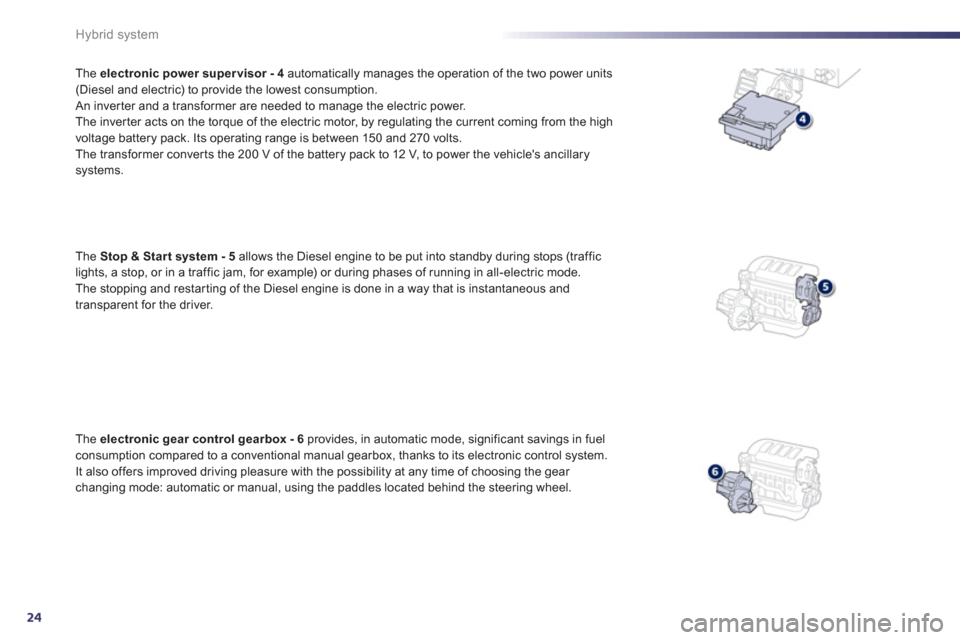
24
Hybrid system
The electronic power super visor - 4automatically manages the operation of the two power units(Diesel and electric) to provide the lowest consumption.
An inver ter and a transformer are needed to manage the electric power.
The inver ter acts on the torque of the electric motor, by regulating the current coming from the high
voltage battery pack. Its operating range is between 150 and 270 volts.
The trans
former conver ts the 200 V of the battery pack to 12 V, to power the vehicle's ancillary
systems.
Th
e Stop & Star t system - 5
allows the Diesel engine to be put into standby during stops (traffic
lights, a stop, or in a traffic jam, for example) or during phases of running in all-electric mode.
The stopping and restar ting of the Diesel engine is done in a way that is instantaneous and
transparent for the driver.
Th
e electronicgear controlgearbox - 6 provides, in automatic mode, significant savings in fuel consumption compared to a conventional manual gearbox, thanks to its electronic control system.
It also offers improved driving pleasure with the possibility at any time of choosing the gear changing mode: automatic or manual, using the paddles located behind the steering wheel.
Page 31 of 302

.
29
!
Hybrid system
Ready lamp
With the gear lever in position N, press the
brake pedal and star t the hybrid system.
This lamp comes on when the vehicle is read
y
to move off ("Auto" mode is on by default) andso the driver can press the accelerator.
This lamp comes on more or less instantly but may take a few seconds in some cases (inparticular, the time needed for pre-heating the
Diesel engine in cold weather).
HYbrid4 mode selector
AUTOmode, for normal use and optimised fuelconsumption.
ZEVmode, to force electric runnin
g.S
portmode, to make use of the maximum
per formance of the vehicle.
4WDmode, to force the vehicle into 4x4 mode.
When stationary, switch off the hybridsystem and check that the Readylamp is off when you leave the vehicle.Other wise the hybrid system will remainactive. See paragraph "Underbonnet precautions/warnings". Th
e selector allows the user to choose between
4 drive modes for the vehicle.
Turn the dial to the right or left; the mode
selected is confirmed by illumination of thecorresponding indicator.
Page 32 of 302
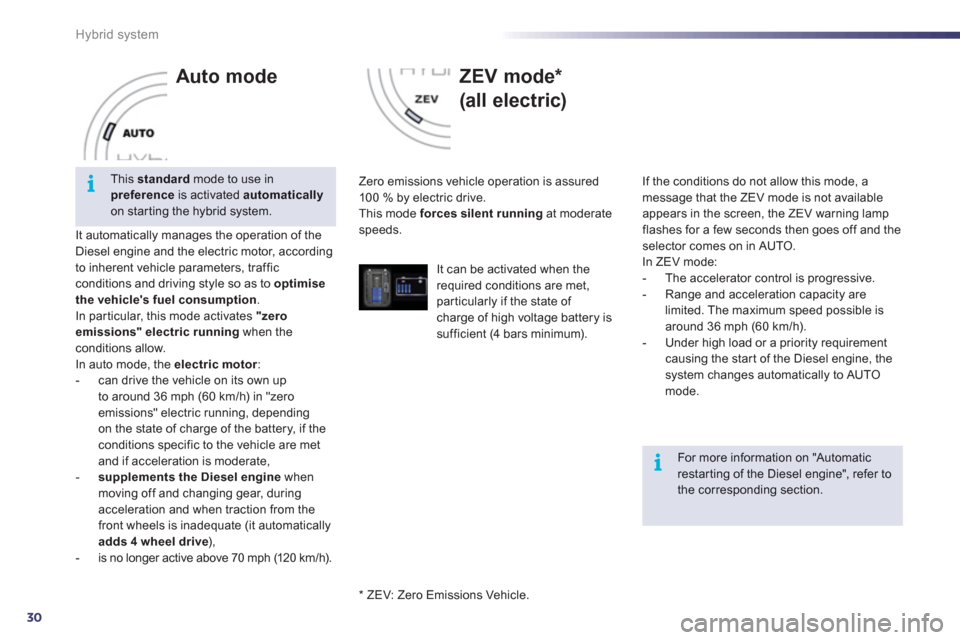
30
i
i
Hybrid system
Auto mode
It automatically manages the operation of the
Diesel engine and the electric motor, according
to inherent vehicle parameters, traffic
conditions and driving style so as to optimise
the vehicle's fuel consumption.In par ticular, this mode activates "zero emissions" electric runningwhen theconditions allow.
In auto mode, the electric motor
:
- can drive the vehicle on its own up
to around 36 mph
(60 km/h) in "zero
emissions" electric running, dependingon the state of charge of the battery, if the conditions specific to the vehicle are metand if acceleration is moderate, -supplements the Diesel enginewhen moving off and changing gear, during acceleration and when traction from thefront wheels is inadequate (it automaticallyadds4 wheel drive ),
- is no longer active above 70 mph (120 km / h).
ZEV mode *
(all electric)
Zero emissions vehicle operation is assured
10 0 % by electric drive.
This mode forces silent runningat moderatespeeds.
If the conditions do not allow this mode
, amessage that the ZEV mode is not available
appears in the screen, the ZEV warning lamp flashes for a few seconds then goes off and theselector comes on in AUTO.
In ZEV mode:
- The accelerator control is progressive.
- Range and acceleration capacity are
limited. The maximum speed possible is
around 36 mph (60 km/h).
- Under high load or a priority requirement causing the star t of the Diesel engine, thesystem changes automatically to AUTO mode.
This standard
mode to use inpreferenceis activated automaticallyon star ting the hybrid system.
For more information on "Automaticrestarting of the Diesel engine", refer tothe corresponding section.
*
ZEV: Z
ero Emissions Vehicle.
It can be activated when the
required conditions are met,
particularly if the state of charge of high voltage battery issufficient (4 bars minimum).
Page 37 of 302
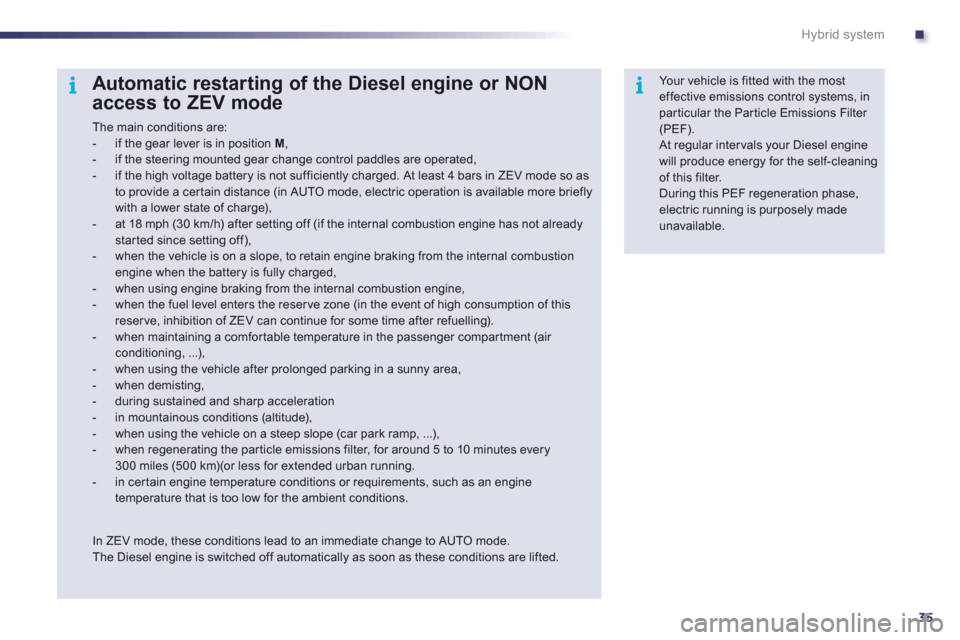
.
35
ii
Hybrid system
Automatic restarting of the Diesel engine or NON
access to ZEV mode
The main conditions are:
- if the gear lever is in position M,
- if the steering mounted gear change control paddles are operated,
- if the high voltage battery is not sufficiently charged. At least 4 bars in ZEV mode so asto provide a cer tain distance (in AUTO mode, electric operation is available more brieflywith a lower state of charge),
- at 18 mph (30 km/h) after setting off (if the internal combustion engine has not alreadystar ted since setting off),
- when the vehicle is on a slope, to retain engine braking from the internal combustion engine when the battery is fully charged,
- when using engine braking from the internal combustion engine,
- when the fuel level enters the reser ve zone (in the event of high consumption of thisreser ve, inhibition of ZEV can continue for some time after refuelling).
- when maintaining a comfor table temperature in the passenger compar tment (air conditioning, ...),
- when using the vehicle after prolonged parking in a sunny area,
- when demisting,
- during sustained and sharp acceleration
- in mountainous conditions (altitude),
- when using the vehicle on a steep slope (car park ramp, ...),
- when regenerating the par ticle emissions filter, for around 5 to 10 minutes every300 miles (500 km)(or less for extended urban running.
- in cer tain engine temperature conditions or requirements, such as an enginetemperature that is too low for the ambient conditions.
In ZEV mode, these conditions lead to an immediate change to AUTO mode. The Diesel engine is switched off automatically as soon as these conditions are lifted.
Your vehicle is fitted with the most effective emissions control systems, inparticular the Particle Emissions Filter (PEF).
At regular intervals your Diesel engine will produce energy for the self-cleaningof this filter.
During this PEF regeneration phase,electric running is purposely madeunavailable.
Page 39 of 302

.
37
Hybrid system
Eco-driving
Eco-driving is a range of everyday practices that allow the motorist to optimise their fuel consumption and CO2 emissions.
Optimise the use of your
gearbox
Use automatic mode Aas much as possible as this optimises gear changes to suit the
circumstances.
Drive smoothly
Maintain a safe distance between vehicles, use engine braking rather than the brake pedal, and press the accelerator progressively. These practices contribute towards a reduction in fuel consumption and CO2 emissions and also helps reduce thebackground traffic noise.
If your vehicle has cruise control, make use of the system at speeds above 25 mph (40 km/h) when the traffic is flowing well.
Control the use of your
electrical equipment
Before moving off, if the passenger compartment is too warm, ventilate it byopening the windows and air vents before using the air conditioning.
Above 30 mph (50 km/h), close the windowsand leave the air vents open. Remember to make use of equipment that canhelp keep the temperature in the passenger compartment down (sun roof and window blinds...).Switch off the air conditioning, unless it has automatic digital regulation, as soon as the desired temperature is attained.Switch off the demisting and defrosting controls, if not automatic.
Switch off the heated seat as soon as possible.
Switch off the headlamps and front foglampswhen the level of light does not require their use.
Avoid running the Diesel engine when stationary, par ticularly in winter; your vehiclewill warm up much faster while driving.
As a passenger, if you avoid connecting your multimedia devices (film, music, video game...), you will contribute towards limitingthe consumption of electrical energy, and soof fuel.
Disconnect your por table devices beforeleaving the vehicle.
Page 40 of 302
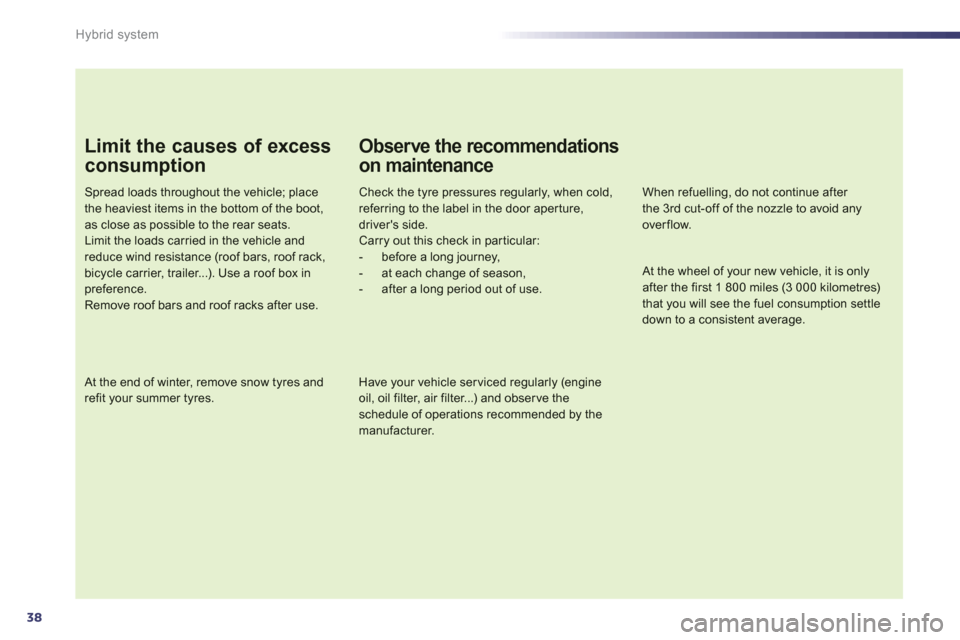
38
Hybrid system
Limit the causes of excess
consumption
Spread loads throughout the vehicle; placethe heaviest items in the bottom of the boot,as close as possible to the rear seats.Limit the loads carried in the vehicle andreduce wind resistance (roof bars, roof rack,bicycle carrier, trailer...). Use a roof box in preference.Remove roof bars and roof racks after use.
At the end of winter, remove snow tyres and refit your summer tyres.
Observe the recommendations
on maintenance
Check the tyre pressures regularly, when cold, referring to the label in the door aper ture, driver's side. Carry out this check in par ticular:
- before a long journey,
- at each change of season,
- after a long period out of use.
Have your vehicle ser viced regularly (engine oil, oil filter, air filter...) and obser ve the schedule of operations recommended by the
manufacturer.
When refuelling, do not continue after the 3rd
cut-off of the nozzle to avoid any overflow.
At the wheel of your new vehicle, it is onlyafter the first 1 800 miles (3 000 kilometres) that you will see the fuel consumption settle down to a consistent average.
Page 47 of 302
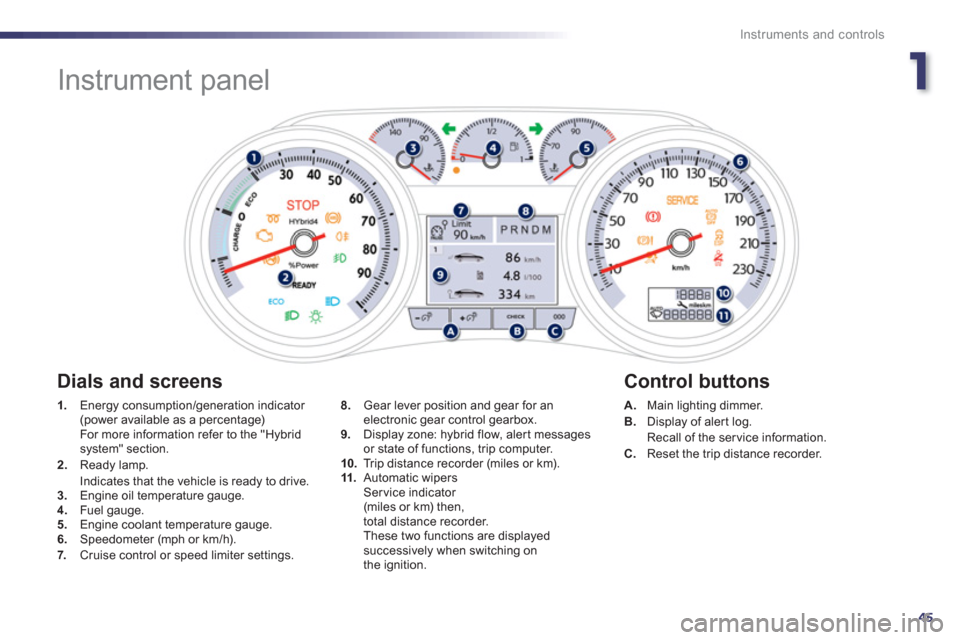
1
45
Instruments and controls
Instrument panel
1.
Energy consumption/generation indicator (power available as a percentage) For more information refer to the "Hybrid system" section. 2.Ready lamp.
Indicates that the vehicle is ready to drive. 3.Engine oil temperature gauge. 4. Fuel gauge.
5. Engine coolant temperature gauge.
6.Speedometer (mph or km/h).
7. Cruise control or speed limiter settings.
A.Main lighting dimmer. B.
Display of aler t log.
Recall of the service information.
C. Reset the trip distance recorder.
8. Gear lever position and gear for anelectronic gear control gearbox.
9. Display zone: hybrid flow, alert messages
or state of functions, trip computer.
10.Trip distance recorder (miles or km). 11.Automatic wipersSer vice indicator (miles or km) then,
total distance recorder.
These two functions are displayedsuccessively when switching on
the ignition.
Dials and screens
Control buttons
Page 48 of 302
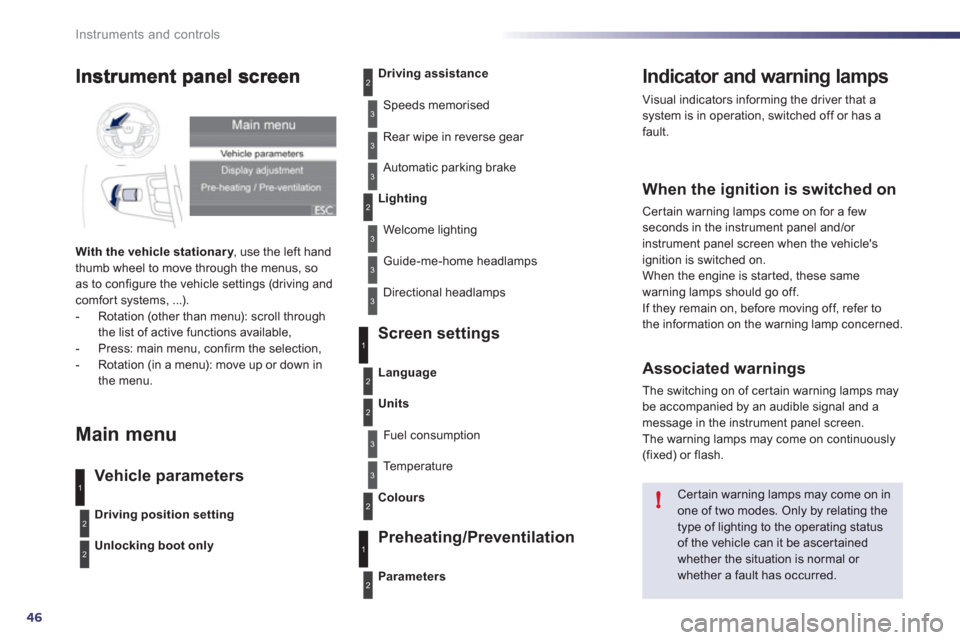
46
!
Instruments and controls
Indicator and warning lamps
Visual indicators informing the driver that a system is in operation, switched off or has a fault.
When the ignition is switched on
Certain warning lamps come on for a few seconds in the instrument panel and/or
instrument panel screen when the vehicle's
ignition is switched on.
When the engine is started, these same
warning lamps should go off.
If they remain on, before moving off, refer to
the information on the warning lamp concerned.
Associated warnings
The switching on of cer tain warning lamps maybe accompanied by an audible signal and a message in the instrument panel screen.
The warning lamps may come on continuously(fixed) or flash.
Certain warning lamps may come on inone of two modes. Only by relating thetype of lighting to the operating status
of the vehicle can it be ascertainedwhether the situation is normal or whether a fault has occurred.
1
2
2
2
3
3
3
2
3
3
With the vehicle stationar y
, use the left handythumb wheel to move through the menus, so as to configure the vehicle settings (driving andcomfort systems, ...).
- Rotation (other than menu): scroll through
the list of active functions available,
- Press: main menu, confirm the selection,
- Rotation (in a menu): move up or down in
the menu.
Main menu
Vehicle parameters Screen settin
gs
Preheatin
g/Preventilation
Driving position setting
Unlocking boot only
Driving assistance
Speeds memorised
Rear wipe in reverse
gear
Automatic parkin
g brake
Lighting
Welcome lighting
Guide-me-home headlamps
Directional headlamps
Parameters
Language
Units
Fuel consumption
Te m p e r a t u r e
Colours
3
1
2
2
3
2
3
1
2